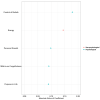Modifiable Resources and Resilience in Racially and Ethnically Diverse Older Women: Implications for Health Outcomes and Interventions
- PMID: 35742334
- PMCID: PMC9223074
- DOI: 10.3390/ijerph19127089
Modifiable Resources and Resilience in Racially and Ethnically Diverse Older Women: Implications for Health Outcomes and Interventions
Abstract
Introduction: Resilience-which we define as the "ability to bounce back from stress"-can foster successful aging among older, racially and ethnically diverse women. This study investigated the association between psychological resilience in the Women's Health Initiative Extension Study (WHI-ES) and three constructs defined by Staudinger's 2015 model of resilience and aging: (1) perceived stress, (2) non-psychological resources, and (3) psychological resources. We further examined whether the relationship between resilience and key resources differed by race/ethnicity. Methods: We conducted a secondary analysis on 77,395 women aged 62+ (4475 Black or African American; 69,448 non-Hispanic White; 1891 Hispanic/Latina; and 1581 Asian or Pacific Islanders) who enrolled in the WHI-ES, which was conducted in the United States. Participants completed a short version of the Brief Resilience Scale one-time in 2011. Guided by Staudinger's model, we used linear regression analysis to examine the relationships between resilience and resources, adjusting for age, race/ethnicity, and stressful life events. To identify the most significant associations, we applied elastic net regularization to our linear regression models. Findings: On average, women who reported higher resilience were younger, had fewer stressful life events, and reported access to more resources. Black or African American women reported the highest resilience, followed by Hispanic/Latina, non-Hispanic White, and Asian or Pacific Islander women. The most important resilience-related resources were psychological, including control of beliefs, energy, personal growth, mild-to-no forgetfulness, and experiencing a sense of purpose. Race/ethnicity significantly modified the relationship between resilience and energy (overall interaction p = 0.0017). Conclusion: Increasing resilience among older women may require culturally informed stress reduction techniques and resource-building strategies, including empowerment to control the important things in life and exercises to boost energy levels.
Keywords: Women’s Health Initiative; aging; race/ethnicity; resilience; resources; women’s health.
Conflict of interest statement
The authors declare no conflict of interest.
Figures



Similar articles
-
Resiliency Among Women's Health Initiative Women Aged 80 and Older by Race, Ethnicity, and Neighborhood Socioeconomic Status.J Gerontol B Psychol Sci Soc Sci. 2023 Aug 28;78(9):1445-1458. doi: 10.1093/geronb/gbad048. J Gerontol B Psychol Sci Soc Sci. 2023. PMID: 36933001 Free PMC article.
-
Resilience and CVD-protective Health Behaviors in Older Women: Examining Racial and Ethnic Differences in a Cross-Sectional Analysis of the Women's Health Initiative.Nutrients. 2020 Jul 16;12(7):2107. doi: 10.3390/nu12072107. Nutrients. 2020. PMID: 32708626 Free PMC article.
-
Diverse demands and resources among racially/ethnically diverse caregivers.Ethn Health. 2023 Aug;28(6):912-931. doi: 10.1080/13557858.2023.2179022. Epub 2023 Mar 1. Ethn Health. 2023. PMID: 36858966
-
Culturally competent HIV prevention strategies for women of color in the United States.Health Care Women Int. 2005 Jan;26(1):17-45. doi: 10.1080/07399330590885795. Health Care Women Int. 2005. PMID: 15764459 Review.
-
Health is Power: an ecological, theory-based health intervention for women of color.Contemp Clin Trials. 2011 Nov;32(6):916-23. doi: 10.1016/j.cct.2011.07.008. Epub 2011 Jul 18. Contemp Clin Trials. 2011. PMID: 21782975 Free PMC article. Review.
Cited by
-
Resiliency Among Women's Health Initiative Women Aged 80 and Older by Race, Ethnicity, and Neighborhood Socioeconomic Status.J Gerontol B Psychol Sci Soc Sci. 2023 Aug 28;78(9):1445-1458. doi: 10.1093/geronb/gbad048. J Gerontol B Psychol Sci Soc Sci. 2023. PMID: 36933001 Free PMC article.
-
Disparities and protective factors in pandemic-related mental health outcomes: a Louisiana-based study.Front Public Health. 2024 Aug 8;12:1404897. doi: 10.3389/fpubh.2024.1404897. eCollection 2024. Front Public Health. 2024. PMID: 39175898 Free PMC article.
-
Diet Quality and Resilience through Adulthood: A Cross-Sectional Analysis of the WELL for Life Study.Nutrients. 2024 May 31;16(11):1724. doi: 10.3390/nu16111724. Nutrients. 2024. PMID: 38892657 Free PMC article.
-
Gender differences in advanced activities of daily living: evidence from the longitudinal study of health and aging in Mexico 2012-2018.Front Aging. 2025 Jul 28;6:1544493. doi: 10.3389/fragi.2025.1544493. eCollection 2025. Front Aging. 2025. PMID: 40791243 Free PMC article.
-
Life Events, Caregiving, and Risk of Autoimmune Rheumatic Diseases in the Women's Health Initiative Observational Study.Arthritis Care Res (Hoboken). 2023 Dec;75(12):2519-2528. doi: 10.1002/acr.25164. Epub 2023 Jul 14. Arthritis Care Res (Hoboken). 2023. PMID: 37230960 Free PMC article.
References
-
- Masten A.S., Garmezy N. Advances in Clinical Child Psychology. Springer; Berlin/Heidelberg, Germany: 1985. Risk, vulnerability, and protective factors in developmental psychopathology; pp. 1–52.
-
- Staudinger U.M., Greve W. Resilience and Aging. Encyclopedia of Geropsychology. Springer; New York, NY, USA: 2015. pp. 1–9.
-
- Woods N.F., Rillamas-Sun E., Cochrane B.B., La Croix A.Z., Seeman T.E., Tindle H.A., Zaslavsky O., Bird C.E., Johnson K.C., Manson J.E. Aging well: Observations from the Women’s Health Initiative study. J. Gerontol. Ser. A Biomed. Sci. Med. Sci. 2016;71((Suppl. 1)):S3–S12. doi: 10.1093/gerona/glv054. - DOI - PMC - PubMed
Publication types
MeSH terms
Grants and funding
LinkOut - more resources
Full Text Sources

